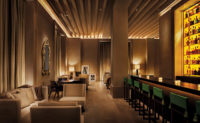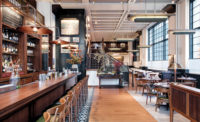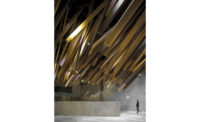What interests David Rockwell most about theater, he says, is the ability to enable storytelling through architecture—an undertaking he and his eponymous firm embraced when New York’s Second Stage Theater asked them to revive an old Broadway house for the company’s new home, and also design the set for its first production in it.
Called the Little Theater when it was built in 1912, the landmarked neo-Georgian building was designed by Harry Creighton Ingalls and F. Burrall Hoffman for impresario Winthrop Ames, to evoke an intimate, salon-like experience, with only 299 seats. Five years later, its interior was renovated by the noted theater architect Herbert Krapp, who added a balcony. It received another overhaul in 1979 and was renamed the Helen Hayes four years later.
After a two-year renovation, it reopened again in February as the Hayes Theater—with about 600 seats, the smallest house on Broadway. Rockwell’s scheme echoes its beginnings, with a beautifully rendered mural on the auditorium walls based on copies of 18th-century French tapestries that hung in the original space. Working with EverGreene Architectural Arts, Rockwell Group devised a pixelated version of one tapestry scene, stenciling it over the walls, which were painted underneath in blue ombré hues. The existing seats were refurbished and covered in a coppery crushed velvet. To bring the theater up to 21st-century standards, the architects installed new restrooms, an elevator, and insulated glazing, plus HVAC, electrical, fire-safety, and rigging systems. They also restored a lower lobby and historic entrance, updating each with contemporary colors.
Rockwell, who has designed more than a dozen sets—winning a Tony Award for last year’s Broadway revival of She Loves Me—created a spare production for Second Stage’s first show here: a revival of Kenneth Lonergan’s 2001 drama Lobby Hero, which takes place in and outside of a Manhattan apartment house lobby. He did this with an environment onstage that provides a mere suggestion of place—elevator doors, desk, dropped ceiling, and entrance—allowing the audience to see it as the characters do by rotating the lobby sporadically throughout the play. Streetlights and a backlit textural backdrop for the outdoor scenes evoke the city at night.
“I can’t think of any other art form where physical transformation happens in front of you,” says Rockwell. As with his firm’s thoughtful renovation of the Hayes Theater, this deceptively simple and fluid staging captures the audience with its subtle spell.














Post a comment to this article
Report Abusive Comment